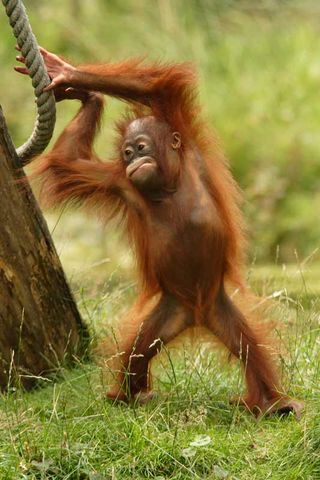Animals Have Personalities, Too

We know our siblings and in-laws have personalities — sometimes to a fault. But science recently has revealed that such individual differences are widespread in the animal kingdom, even reaching to spiders, birds, mice, squid, rats and pigs.
Now a new mathematical model helps to explain how and why such animal temperaments develop over time.
The model explains a central question of both animal and human personality — why certain individuals are more rigid or flexible than others, and why some change their behavior in response to changes in their environment while others do not.
The answer, says Franz Weissing of the University of Groningen, the Netherlands, comes down to costs and benefits. A group in which both rigid and flexible personality types co-exist makes for an optimal system, his model shows.
The field of animal-personality study is starting to gain some substance and credibility, said University of Texas psychologist Sam Gosling, who does research in this field.
"When I started doing this, like 10 years ago, things were really different. I remember people thought it was anthropomorphic [to use the term animal personality]," said Gosling, who was not involved in the recent study.
Prestigious scientific journals are publishing research articles explicitly on the topic of animal personality, he said.
Sign up for the Live Science daily newsletter now
Get the world’s most fascinating discoveries delivered straight to your inbox.
"I think it does reflect a new sense of respect in the field and I think it's opening up all kinds of important opportunities and allowing us to test questions we simply couldn't test without animal studies," Gosling said.
Duck food
Weissing and his colleagues ran various model simulations of scenarios that included a resource as well as responsive and unresponsive animals. He said the new model shows, for example, when it's optimal for animals to react to a change in food and when it's not. It turns out that competing personalities help to keep a healthy balance in a group.
Say you have a duck pond in which, every day, twice as much food is scattered along the right side of the pond, leaving the left side sparse, Weissing said. The ducks learn to paddle to the right side to forage. Then one day, say, more food shows up on the left side of the pond, leaving the right with a dearth.
Experiments have shown that some of the ducks were checking out the left side of the pond all along and will notice and swim to the food on the left. Other ducks, however, will stick to their routine and continue about their business of scarfing up the little bit of food still on the right side.
The responsive ducks benefit from their quick move to the big pile of food, while the unresponsive ducks could starve, or at the very least, not get a bellyful.
The tables turn if too many ducks were to respond and head over to the left side of the pond. In this model scenario, the competition on that side of the pond would skyrocket, leaving some of these seeming smarty pants with little food. Meanwhile, the unresponsive ducks would benefit in this scenario, because while they would be left with a smaller portion of food, there would be hardly any competition for it.
In some of the model simulations, responsiveness could also be a waste of energy. If say the food never moves to the other side of the pond, the proactive ducks could exhaust themselves to no avail.
In the end, a balance between ducks that scan for change and ducks that stick with the routine would benefit the overall population.
Individuals coexist
The researchers also found animal personalities tend to persist. That's because, as the adage goes, practice makes perfect. Individuals who are responsive gain experience, so it behooves them to continue such behavior in the future.
"Individuals that have been responsive before have a slight advantage in collecting or interpreting environmental cues," Weissing told LiveScience. "This is a plausible assumption, since the performance of individuals generally improves with the experience they have."
Similar personality types also exist in humans. "Some humans behave rather routine, in a rigid way. And others behave in a rather flexible way," Weissing said. "The first type is rather traditional, conservative, always following the trodden path of the past, whereas the other type is more interested in change, interested in the environment, always sampling the environment."
While the model simulations didn't directly analyze human behavior, Weissing said there is a crossover between non-human animals and the rest of the animal kingdom.
The research, detailed online this week by the Proceedings of the National Academy of Sciences, was funded by the Netherlands Organization for Scientific Research.
- 10 Amazing Things You Didn't Know About Animals
- Video – Extraordinary Birds
- Do Fish Cry?

Jeanna served as editor-in-chief of Live Science. Previously, she was an assistant editor at Scholastic's Science World magazine. Jeanna has an English degree from Salisbury University, a master's degree in biogeochemistry and environmental sciences from the University of Maryland, and a graduate science journalism degree from New York University. She has worked as a biologist in Florida, where she monitored wetlands and did field surveys for endangered species. She also received an ocean sciences journalism fellowship from Woods Hole Oceanographic Institution.
Most Popular

